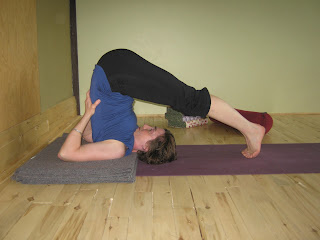Ardha Halasana - Half Plough Pose
This month I thought I would add an inversion.
Ardha Halasana, meaning half plough for the shape it resembles, is a great pose to start with if you are just beginning inversions. This variation is for beginners. The next pose I will add steps to the final stages and then work up into Salamba Sarvangasana (supported shoulder stand). It is important to learn how to get the lift in the spine and trunk so that the chest can expand correctly. Don't miss steps to get to the final pose as every step is important.
Begin by placing the short end of the mat into the wall. Stack 3-5 blankets neatly near the wall as shown above with the folded edge out. Come to the floor, bringing the sitting bones near the wall and roll onto the blankets so you are in the centre of the blankets.
Adjust your body so that the top edge of the shoulders are 2-3 inches from the top of the blankets and the back of your head is on the floor. Keep the buttock bones near the wall and bring the soles of the feet into the wall with the knees bent.
This is a beginner variation. Press into the feet and upper arms and draw the tailbone up. Lift the spine and tailbone vertically up. Bring the hands to the back and keep walking hands down the back to keep the spine lifting. Try to keep the elbows in line with the shoulders, this will help lift and open the chest more. Stay for 2-3 minutes, working up to 5 minutes.
To come out of the pose, slowly release the arms and lower the hips back to the floor.
Stay with the previous variation until you feel comfortable.
The next stage will be to bring the legs down one at a time and place the toes onto a chair or bench. Take the chest and hips slightly back to maintain the extension of the body.
Keep the hands moving down the back towards the shoulder blades and press the thoracic spine in, moving the breastbone towards the chin.
Lengthen the side body. Keep the legs straight by pulling the kneecaps to the thighs and the thigh muscles up to the hips to engage thigh muscles. Press the thighbones up and away from the face and keep stretching the back of the legs.
To come out of the pose, bend the knees and slowly roll down the back -vertebra by vertebra and lower hips to the floor.
Rest for a few breaths by sliding the head and body forward, off the height, so only the lower back and hips are on the blankets.
Roll to the right and press the floor to come up.
Benefits:
Helps reduce fatigue, insomnia and anxiety, calms the nerves and relieves breathlessness and helps regulate blood pressure.
Circulation is increased to the neck and face and reduces aging effects of wrinkles, tension and dehydration and improves the functioning of the thyroid and parathyroid glands.
Restores health to pelvic organs, and can help relieve backache.
Cautions:
Avoid inversions during menstruation.
Avoid if have a neck or shoulder injury or have a headache.
Namaste.
Pamela Nelson
www.plnyoga.vpweb.com











